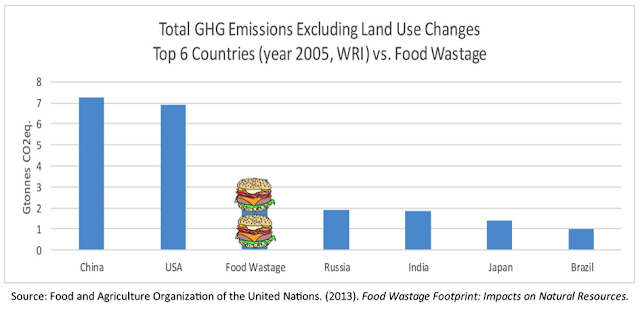I dig through trash. And, I take pictures of trash cans on vacations. Most of my friends learn to appreciate, or rather tolerate, this about me. For all of you thinking “ewwwwww….,” I wash my hands afterwards!
One thing I quickly noticed when digging through trash is that ooey gooey food is a huge component of what we throw away. In fact, it is the number one material reaching landfills in the United States (1). That is enough to fill the Rose Bowl Stadium each day to the brim (2)!
Why should we care about wasted food?
Of food grown in the United States, 40% never reaches anyone’s plate. (3)
While we are throwing away more food than ever in human history, 14% of Americans are food insecure, meaning they don’t get enough food to live active, healthy lifestyles. (4)
13% of U.S. greenhouse gas emissions are associated with the lifecycle of food (5)!
Growing food in the U.S. accounts for 10% of the total energy budget, 50% of land, and 80% of all freshwater consumed (3). By throwing away an apple or a piece of pizza, we also waste all of the resources (pesticides, water, fertilizer, etc.) that went into growing, manufacturing, and distributing the food.
Wasted food is estimated to cost the United States $165 billion per year which is equivalent to the GDP of the Ukraine (3).
According to the United Nations Food and Agriculture Organization (FAO), if wasted food were a country, it would be the third largest emitter of GHGs in the world, behind China and the United States (6). And, we aren’t just wasting banana peels and peach pits! Of the 1.6 billion tonnes of food wasted globally each year, 1.3 billion tonnes is edible (6).

While I worked at the Environmental Protection Agency as a regional food waste expert, I witnessed many things that made me realize now is the time to combat the waste of food. I saw several tons of untouched canned soup that had been improperly labeled and was destined for the landfill. I saw perfectly edible food in the trash cans of restaurants and grocery stores. And, I saw produce thrown away or left on the farm because it was too small, not round enough, or not expected to last three months in refrigerated trucks. I do not cast blame on any of these actors, but rather call on all of us to make a cultural and policy shift to value food rather than waste it. I do not know the answer, but I do know it will take all of us to fix this global food waste epidemic.
It doesn’t matter if the food we grow is organic, local, non-GMO, or [insert any other adjective] if we waste it. So, next time you take out your trash, think about what is inside your trash bag and ways you can reduce your waste. If you need, I am always around to dig through your trash for you! And remember, food is too good to waste!
Sources:
- U.S. Environmental Protection Agency. (2013). Municipal Solid Waste in the United States: 2011 Facts and Figures (EPA 530-R-13-001). Washington, DC.
- Bloom, Jonathan. (2011). American Wasteland: How America Throws Away Half Its Food.
- Gunders, D. (2012). Wasted: How America is Losing Up to 40 Percent of Its Food from Farm to Fork to Landfill. Natural Resources Defense Council.
- U.S. Department of Agriculture. (2013). Household Food Security in the United States in 2012. Washington, DC.
- U.S. Environmental Protection Agency. (2009). Opportunities to Reduce Greenhouse Gas Emissions through Materials and Land Management Practices (EPA 530-R-09-017). Washington, DC.
- Food and Agriculture Organization of the United Nations. (2013). Food Wastage Footprint: Impacts on Natural Resources.